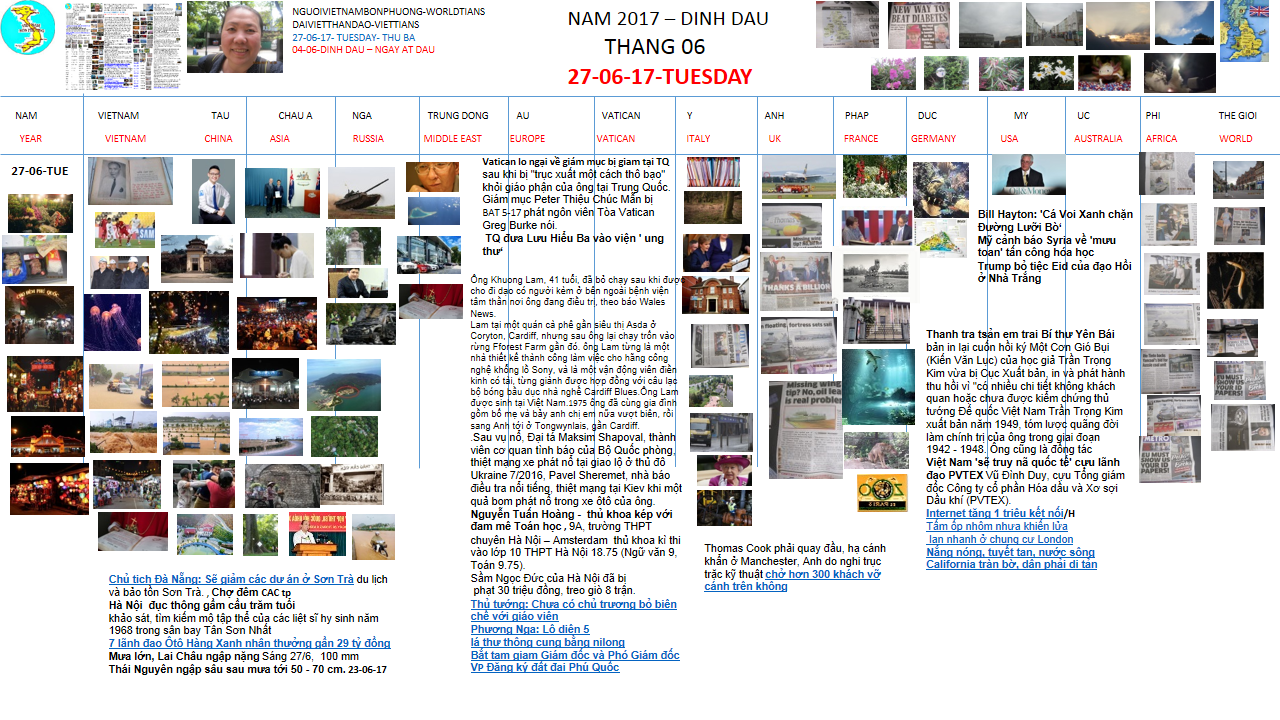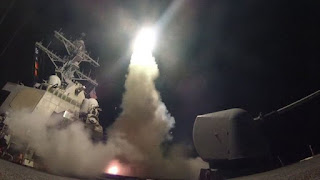NGUOIVIETNAMBONPHUONG- WORLDTIANS
DAIVIETTHANDAO-VIETTIANS
27-06-17-TUESDAY- THU BA
04-06-DINH DAU – 17H20
Columbia The
Spanish set foot on Colombian soil for the first time in 1499 and in the first
half of the 16th century initiated a period of conquest
and colonization, ultimately creating the New Kingdom of
Granada, with as capital Santafé de Bogotá. Independence
from Spain was
acquired in 1819, but by 1830 the "Gran Colombia"
Federation was dissolved. What is now Colombia and Panama emerged as the Republic of New
Granada. The new nation experimented with federalism as the Granadine Confederation (1858),
and then the United States of
Colombia (1863), before the Republic of Colombia w s finally declared
in 1886. Panama
seceded in 1903. Since the 1960s, the country has suffered from an
asymmetric low-intensity armed
conflict, which escalated in the 1990s but then decreased from 2005 onward.[13] Colombia is
one of the most ethnically and linguistically diverse
countries in the world, and thereby possesses a rich cultural heritage.
The urban centres are mostly located in the highlands of the Andes mountains.
20-07-1810-
Declared , 7 August 1819- Recognized ,1886 - 4 July 1991
1,141,748 km2 6-2017- 49,829,325[3] GDP 2017-
720.151 bn$
he present
territory of Colombia was a corridor of early human migration from Mesoamerica and
the Caribbean to
the Andes and Amazon basin. The oldest
archaeological finds are from the Pubenza and El
Totumo sites
in the Magdalena Valley 100 kilometres (62 mi) southwest of Bogotá.[19] These sites
date from the Paleoindian period
(18,000–8000 BCE). At Puerto Hormiga and
other sites, traces from the Archaic
Period (~8000–2000 BCE) have been found. Vestiges indicate that
there was also early occupation in the regions of El Abra and Tequendama in Cundinamarca.
The oldest pottery discovered in the Americas, found at San
Jacinto, dates to 5000–4000 BCE
Colombia by
12,500 BCE. Nomadic hunter-gatherer tribes
at the El Abra, Tibitó and Tequendama sites near
present-day Bogotá traded
with one another and with other cultures from the Magdalena River Valley.[21] Between 5000
and 1000 BCE, hunter-gatherer tribes transitioned to agrarian societies;
fixed settlements were established, and pottery appeared. Beginning in the 1st
millennium BCE, groups of Amerindians including
the Muisca, Quimbaya,
and Tairona developed
the political system of cacicazgos with a
pyramidal structure of power headed by caciques. The
Muisca inhabited mainly the area of what is now the Departments of Boyacá and Cundinamarca high
plateau (Altiplano Cundiboyacense)
where they formed the Muisca Confederation.
They farmed maize, potato, quinoa and cotton, and traded gold, emeralds, blankets,
ceramic handicrafts, coca and especially rock salt with neighboring
nations. The Tairona inhabited northern Colombia in the isolated mountain range
of Sierra
Nevada de Santa Marta.[22] The
Quimbaya inhabited regions of the Cauca River Valley
between the Western and Central Ranges
of the Colombian Andes.[23] Most
of the Amerindians practiced agriculture and the social structure of each
indigenous community was different.
indigenous people such as the Caribs lived in a state of permanent war,
but others had less bellicose attitudes.[24] The Incas
expanded their empire onto
the southwest part of the country
Alonso de Ojeda (who
had sailed with Columbus) reached the Guajira Peninsula in
1499.[26][27] Spanish
explorers, led by Rodrigo de Bastidas, made the
first exploration of the Caribbean coast in
1500.[28] Christopher Columbus navigated
near the Caribbean in 1502.[29] In
1508, Vasco Núñez de Balboa accompanied
an expedition to the territory through the region of Gulf of Urabá and they
founded the town of Santa
María
la Antigua del Darién in 1510, the first stable settlement on the
continent
Santa Marta was
founded in 1525,[31] and Cartagena in
1533.[Sebastián de Belalcázar,
conqueror of Quito,
traveled north and founded Cali,
in 1536, and Popayán,
in 1537;[35] from
1536 to 1539, German onquistador Nikolaus Federmann crossed
the Llanos
Orientales and
went over the Cordillera
Oriental in a search for El Dorado, the "city of
gold". 1542, the region of New Granada, along with all other Spanish
possessions in South America, became part of the Viceroyalty of Peru,
with its capital at Lima.[46] In 1547, New
Granada became the Captaincy-General
of New Granada within the viceroyalty.1549, the Royal Audiencia was
created by a royal decree, and New Granada was ruled by the Royal
Audience of Santa Fe de Bogotá, which at that time comprised the provinces
of Santa Marta, Rio de San Juan, Popayán, Guayana and Cartagena
The Congress of Cúcuta in
1821 adopted a constitution for
the new Republic.[78][79] Simón Bolívar
became the first President of
Colombia, and Francisco de Paula Santander was made Vice President.[80]However, the new
republic was unstable and three countries emerged from the collapse of Gran Colombia in
1830 (New Granada, Ecuador and Venezuela).Colombia was the first constitutional
government in South America,[83] and the Liberal and Conservative parties,
founded in 1848 and 1849 respectively, are two of the oldest surviving political parties in
the Americas.[84] Slavery was abolished in
the country in 1851..The United States paid Colombia $25,000,000 in 1921, seven
years after completion of the canal, for redress of President Roosevelt's
role in the creation of Panama, and Colombia recognized Panama under the terms
of the Thomson–Urrutia Treaty..
1960s, the
country has suffered from an asymmetric low-intensity armed
conflict between the government
forces, left-wing
guerrilla groups and right-wing
paramilitaries.[102] The
conflict escalated in the 1990s,[103] mainly in
remote rural areas
The United
States has been heavily involved in the conflict since its beginnings, when in
the early 1960s the U.S.
government encouraged the Colombian military to attack leftist
militias in rural Colombia. This was part of the U.S. fight against communism
4 July 1991, a new Constitution was
promulgated. The changes generated by the new constitution are viewed as
positive by Colombian society.
Chlorochrysa nitidissima. Colombia is home to more bird
species than any other country in the world. The national flower of Colombia is
the orchid Cattleya trianae, which
was named after the Colombian botanist and physician José Jerónimo Triana
Jorge Isaacs was one
of the greatest exponents of Colombian literature in the nineteenth century.
Colombian music blends European-influenced guitar and song structure
with large gaita flutes and percussion
instruments from the indigenous population, while its percussion
structure and dance forms
come from Africa
common
ingredients are: cereals such as rice and maize; tubers such as potato
and cassava;
assorted legumes;
meats, including beef, chicken, pork and goat; fish; and seafood as cape gooseberry, feijoa, arazá, dragon fruit, mangostino, granadilla, papaya, guava, mora (blackberry), lulo, soursop and passionfruit.[368] Colombia is
one of the world's largest consumers of fruit juices Sancocho
de gallina criolla is a traditional soup in Colombia.
Cộng hoà Colombia , uốc gia tại Nam Mỹ. Colombia
giáp Venezuela và Brasil về phía đông;
giáp Ecuador và Peru về phía nam; giáp Đại
Tây Dương phía bắc, qua Biển Caribe; và
phía tây giáp Panama và Thái
Bình Dương.
2006:
"Dù số lượng các vụ giết hại và bắt cóc ở một số vùng trong nước đã giảm,
nhiều trường hợp vi phạm nhân quyền nghiêm trọng do tất cả các bên trong cuộc
xung đột tiến hành vẫn ở mức độ báo động. Đặc biệt lo ngại là các báo cáo về những
vụ hành
quyết không cần xét xử do các lực lượng vũ trang tiến hành, những vụ
giết hại thường dân bởi các nhóm vũ trang đối lập và bán du kích, và việc ép buộc
các cộng đồng dân cư phải dời bỏ chỗ ở. 55 phần trăm số người phải dời bỏ nhà cửa
là phụ nữ. Bạo hành tình dục,
1.141.748 km² , 49,210,124 , 2017- GDP - 720,151 tỷ US
10000
trước Công Nguyên, các xã hội săn
bắn hái lượm đã tổn tại gần nơi hiện là Bogotá (tại "El Abra"
và "Tequendama") họ buôn bán với nhau và với các nền văn hóa sống dọc
Châu thổ Sông
Magdalena. Bắt đầu thiên niên kỷ thứ nhất trước Công Nguyên, các nhóm người Amerindians đã
phát triển các hệ thống chính trị gồm các "cacicazgo"
với một cơ cấu quyền lực hình kim tự tháp đứng đầu là các tù trưởng.
Bên trong Colombia, hai nền văn hóa có hệ thống cacicazgo phức tạp nhất
là Tayrona tại vùng Caribe, và Muisca tại
các cao nguyên quanh Bogotá,
cả hai đều thuộc ngữ hệ Chibcha.
Người Muisca được coi là đã sở hữu một trong những hệ thống chính trị phức tạp
nhất tại Nam Mỹ,
sau người Inca 1500 dưới sự
lãnh đạo của Rodrigo
de Bastidas. Christopher
Columbus đã tới gần Caribe năm 1502. Năm 1508, Vasco
Nuñez de Balboa bắt đầu chinh phục lãnh thổ này qua vùng Urabá. Năm
1513, ông cũng là người châu Âu đầu tiên khám phá Thái
Bình Dương mà ông gọi là Mar del Sur 1525,
thành phố châu Âu đầu tiên tại lục địa châu Mỹ được
thành lập, là Santa
María la Antigua del Darién tại Khu Chocó ngày
nay. thế kỷ mười sáu, người
châu Âu bắt đầu đưa nô lệ từ Châu Phi tới.
đòi độc lập từ Tây Ban Nha, nổ ra khoảng năm 1810, sau khi St. Domingue
giành độc lập năm 1804 (Haiti ngày nay) Simón
Bolívar đã trở thành tổng thống đầu tiên của Colombia/ Fransisco de Paula
Santander là Phó
tổng
thống 1819 khi lãnh
thổ Phó
vương New Granada trở thành nhà nước Cộng hòa Đại Colombia được
tổ chức thành một Liên minh cùng Ecuador và Venezuela (Panama từng là một phần của
Colombia). xung đột đẫm máu xảy ra trong khoảng thời gian giữa cuối thập kỷ 1940 và
đầu thập
kỷ 1950, một giai đoạn được gọi là La
Violencia (ám sát ứng cử viên Tổng thống Tự
do Jorge
Eliécer
Gaitán ngày 9 tháng 4 năm 1948. 1970-1980 tổ
hợp
ma tuý (drug
cartel) giàu mạnh và đầy tính bạo lực xuất hiện, hiến pháp mới đã được phê chuẩn năm 1991 2006 Chính phủ Colombia đã phá hủy khoảng
73.000 hécta (180.387 acres) vượt mọi kỷ lục trong trồng cây
coca. Colombia theo chế độ Cộng hoà Tổng thống là Nguyên
thủ quốc gia và đứng đầu Chính phủ, được
bầu trực tiếp nhiệm kỳ 4 năm và có thể tái cử ở nhiệm kỳ tiếp theo. đồng minh
chiến lược với Mỹ,
coi Mỹ là
bạn hàng chính và nguồn cung cấp viện trợ quan trọng (khoảng 5 tỷ USD trong
8 năm qua, à nước nhận viện trợ nhiều nhất của Mỹ ở Mỹ Latinh).
95% dân số là Kitô hữu
Ajiaco, is a soup Asado Bogotano
2-4-2017- Colombia landslides: Over 200 die
in Putumayo floods
26-06-17-tàu du lịch 4 tầng 150 hành khách gặp
nạn hồ chứa nước Penol-Guatape, vùng Antokia, phía Bắc Columbia 6 CHET

























































































































































































































































































No comments:
Post a Comment